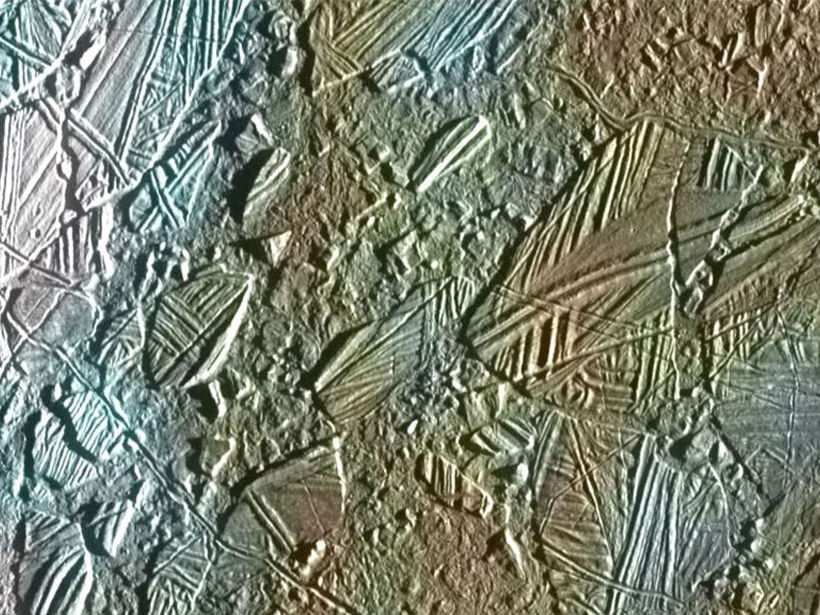If you’re wagering where life might exist beyond Earth, Europa is always a safe bet. That’s because this moon of Jupiter has a liquid-water ocean beneath its icy surface, making it a likely incubator for marine life. Researchers now have shown that Europa’s ocean probably contains sodium chloride (NaCl), the same stuff we sprinkle on our french fries and also the dominant form of salt in our own planet’s ocean.
A Weird, Watery World
Europa, Jupiter’s fourth-largest moon, is an enigmatic world: Ultraviolet auroras dance over its poles, its surface has hot and cool spots, and enormous blades of ice may be clustered around its equator. Since the 1970s, researchers have hypothesized that Europa might harbor a liquid ocean under its icy surface. Spacecraft-based observations have since confirmed Europa’s hidden ocean and shown that it’s salty, and water vapor plumes spotted emanating from the moon have provided additional evidence of its watery interior.
Samantha Trumbo, a planetary scientist at the California Institute of Technology in Pasadena, and her colleagues now have studied the chemistry of Europa’s ocean. They did so by investigating the moon’s surface, specifically, geologically young regions called “chaos terrain” where ocean water likely upwells. In these areas, the icy surface looks to have been wrenched apart, said Trumbo. “These regions are probably the most representative of the internal composition [of Europa].”
Hubble Space Telescope Looks for Salt
In 2017, Trumbo and her collaborators collected spectroscopic observations of Europa’s surface using the Hubble Space Telescope. The data, with a spatial resolution of roughly 150 kilometers, spanned from ultraviolet to infrared wavelengths.
The researchers were looking for two absorption features characteristic of sodium chloride that’s been bombarded by high-energy electrons. (These electrons, which originate mostly from volcanic eruptions on Jupiter’s moon Io, alter NaCl’s crystalline structure.) The two absorption features fall within the blue and red parts, respectively, of the visible spectrum.
Finding evidence of sodium chloride was a bit of a surprise.
Trumbo and her team found just the absorption feature in the blue part of the visible spectrum, which actually makes sense, said Trumbo. Laboratory experiments that re-create the absorption in the red part of the visible spectrum bombard sodium chloride with 10,000–100,000 times the true radiation flux at Europa’s surface, she said. “At the real flux levels of Europa, this feature would never form.”
Finding evidence of sodium chloride was a bit of a surprise, said Trumbo. “Sulfates on the surface of Europa have been the prevailing view since the Galileo mission in the 1990s.”
To confirm that sodium chloride was really the cause of the absorption they observed, the researchers took spectra of other irradiated salts like magnesium sulfate (MgSO4), calcium carbonate (CaCO3), and magnesium chloride (MgCl2) in the laboratory. None of the compounds they tested exhibited absorption in the blue part of the visible spectrum, and several had strong absorption features at other wavelengths that the researchers didn’t see in their Hubble data.
Concentrated in Chaos
Trumbo and her colleagues found that sodium chloride on Europa was mainly concentrated in the chaos terrain. Because that’s where subsurface water likely upwells, this finding is consistent with the salt deriving from the moon’s ocean, the researchers suggest.
If NaCl exists in the moon’s subsurface ocean, it “suggests that Europa’s ocean might be more Earth-like compositionwise than previously thought.”
“This marked correlation with geologically young chaos regions suggests an interior source,” they wrote in their paper, which was published in June in Science Advances.
“This new study took a novel approach that combines telescopic observations, laboratory experiments, and geochemical analysis,” Xianzhe Jia, a planetary scientist at the University of Michigan who was not involved in the research, told Eos. If NaCl exists in the moon’s subsurface ocean, it “suggests that Europa’s ocean might be more Earth-like compositionwise than previously thought.”
Scientists are looking forward to getting a closer look at Europa and its ocean with NASA’s Europa Clipper mission, which will put a spacecraft in orbit around Jupiter. The spacecraft, slated to launch in the 2020s, will fly as close as 25 kilometers to Europa’s surface—the closest flyby ever of this moon—and will analyze the celestial body using a suite of cameras, thermal imagers, spectrographs, and ice-penetrating radar.
—Katherine Kornei (@katherinekornei), Freelance Science Journalist
Citation:
Kornei, K. (2019), Mmm, salt—Europa’s hidden ocean may contain the table variety, Eos, 100, https://doi.org/10.1029/2019EO127617. Published on 09 July 2019.
Text © 2019. The authors. CC BY-NC-ND 3.0
Except where otherwise noted, images are subject to copyright. Any reuse without express permission from the copyright owner is prohibited.

